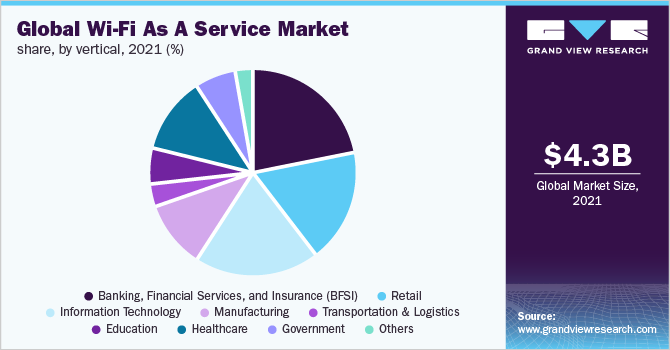The global Wi-Fi as a Service (WaaS) market was valued at USD 4.32 billion in 2021 and is projected to reach USD 24.36 billion by 2030, expanding at a compound annual growth rate (CAGR) of 21.4% from 2022 to 2030. This strong growth trajectory is primarily attributed to the increasing adoption of WaaS, driven by its cost-effectiveness and high scalability.
Rising demand for fast, reliable, and wide-reaching network coverage, along with the increasing implementation of air-gapped services, is fueling market expansion. The deployment of public Wi-Fi networks across a variety of industries—including BFSI, retail, manufacturing, and transportation & logistics—is playing a pivotal role in accelerating demand. Furthermore, organizations are increasingly turning to cloud-managed Wi-Fi solutions due to their flexibility, ease of deployment, and shorter product lifecycle, making them ideal for dynamic IT environments.
Wi-Fi as a Service enables real-time network monitoring and offers access to both live and historical usage data, helping businesses manage their networks more effectively. This makes WaaS particularly suitable for small and medium-sized businesses, temporary setups, and office relocations, as it can be remotely managed via a network operations center (NOC) that ensures rapid and dependable connectivity.

Security remains a core advantage of WaaS, particularly in Bring Your Own Device (BYOD) environments. BYOD integration allows for controlled access to network resources by personal devices, giving IT teams the ability to manage access rights, revoke device access, and remotely wipe data when necessary—enhancing security without compromising flexibility.
WaaS also replaces vulnerable consumer-grade systems with enterprise-level hardware and secure network services, providing users with greater stability, scalability, and advanced protection. The increasing prevalence of BYOD policies and the growing number of internet-connected devices in enterprise IT infrastructure are expected to significantly contribute to market growth during the forecast period.
Key Market Highlights:
- Asia Pacific (APAC) led the global market in 2021 with a 37% revenue share
- By component, the infrastructure segment dominated with around 45% of the revenue in 2021
- By location type, the indoor segment accounted for approximately 80% of the market share in 2021
- By organization size, large enterprises held the largest share at 52% in 2021
- By vertical, the BFSI segment led with 22% of total market revenue in 2021
Download a free sample PDF of the Wi-Fi as a Service Market Intelligence Study from Grand View Research.
Market Performance:
- 2021 Market Size: USD 4.32 Billion
- 2030 Projected Market Size: USD 24.36 Billion
- CAGR (2022–2030): 21.4%
- Leading Region (2021): Asia Pacific
Prominent Companies & Market Dynamics:
The WaaS market is highly consolidated, with intense competition among a number of key players. To gain a competitive edge, companies are focusing on product innovation, strategic partnerships, and technology upgrades. For example, Cisco Inc. introduced new solutions such as the Catalyst 9000X series switches, private 5G as a managed service, and advanced Wi-Fi 6E access points. These offerings are designed to help businesses digitize their infrastructure, support hybrid work models, and scale campus networks effectively.
Key Companies:
- Rogers Communication
- Juniper Networks Inc.
- Dell Technologies
- TP-Link
- Extreme Networks
- Fortinet
- Arista Networks
- D-Link Corporation
- Cambium Networks
- Superloop
Explore Horizon Databook – the most comprehensive market intelligence platform from Grand View Research.
Conclusion
The Wi-Fi as a Service market is on a strong growth path, fueled by increasing demand for scalable, secure, and cloud-managed network solutions. As organizations continue to prioritize flexible connectivity, BYOD policies, and real-time network management, WaaS is emerging as a key enabler of modern, agile IT environments.


No comments:
Post a Comment